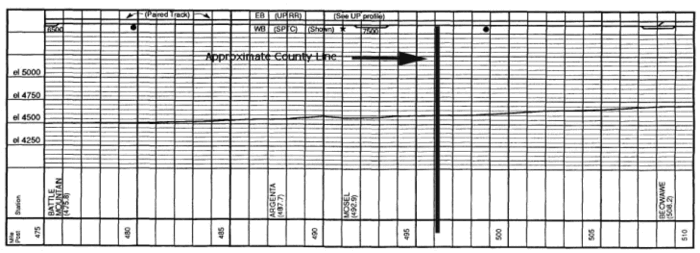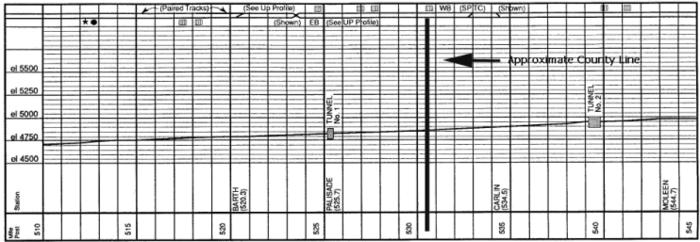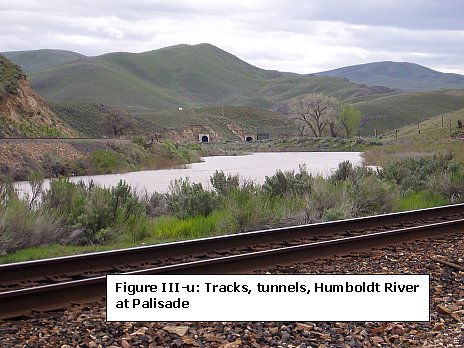

E. Physical Features — Continued
Figure III-t: Profiles of Union Pacific Overland Route Through Eureka County


As the track profiles show, going from west to east, both tracks climb gently in elevation through the study area, with the elevation of the tracks ranging between 4,500 and 5,000 feet. There are two tunnels in Eureka County on the Central Corridor line and one on the Overland line. Two of the tunnels are shown in the photograph below. The tracks cross between Barth and Palisade, at approximately Mile 524 on the Overland line, and approximately Mile 634 on the Central Corridor line. (Figure III - Q shows this crossing).

There are sidings at Mosel (in Lander County) and Beowawe. At Carlin (Elko County) there are switching tracks allowing passage from one track to the other. There are five hot journal detectors and three dragging equipment detectors within the study area. *
Figure III-V (250KB), shows two pages reproduced from a Railfan Timetable™ of the Rocky Mountain region, describing the rail routes through the study area.
On the left of each page are speed zones by milepost. Stations (place names) and automatic detectors are listed in the middle column. Stars signify talking detectors. "X" by a station name (at Carlin, Barth, Beowawe) means a crossover. "M" means manual interlocking. "P" means passenger stop (at Carlin).
The type of track operating rule is the next column to the right. As the timetable shows, the rule is "DT ABS," dual track automatic block signal, through the study area. Location of sidings and their length are in the next column to the right. Below each subdivision profile is a set of special instructions for that subdivision. These list the radio frequencies used by train crews to communicate with the dispatcher, yardmaster and control operator; PBX or mobile telephone frequencies used by crews; passenger trains using the line; detectors; maximum speed; rules applicable to operation on the subdivision; and tunnel location and length.
* A dragging equipment detector is a track device which detects the passage of train wheels that are not properly mated to the rails. A hot journal detector is a track device which measures the relative temperatures of passing journal bearings. Hot journal detectors transmit bearing temperatures to wayside stations, where the information is monitored by personnel who can act to stop a train if an overheated journal is discovered. Some detectors will automatically drop the next signal to a stop indication if an overheated condition is noted.
|



